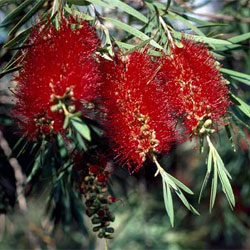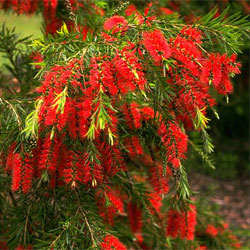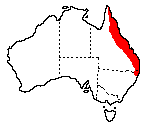Callistemon viminalis
 |
 |
Some herbaria use the name Melaleuca viminalis
Red Bottlebrush, Weeping Bottlebrush, Drooping Bottlebrush
Callistemon viminalis (Sol. ex Gaertn.) G.Don
Melaleuca viminalis (Sol. ex Gaertn.) Byrnes
The genus Callistemon has provided many fine horticultural specimens. They are generally noted for their flowers, adaptability and quick growth. The weeping bottlebrush Callistemon viminalis is a very fine example of the group.
Callistemon viminalis occurs naturally on the east coast of
Australia from Cape York to north-east New South Wales. It is more common
along watercourses on the coastal plains where it forms a shrub or small tree
up to 8 m tall; larger specimens up to 18 m tall have also been recorded.
It also extends to the tablelands and occasionally to the western slopes of
the Great Dividing Range. 
The leaves of C. viminalis are lanceolate 3-6 mm wide by 40-70 mm long but northern forms have a more elliptical-shaped leaf. The flowers are borne in spikes 40-150 mm long with prominent red stamens 15-25 mm long. Petals are greenish or pale coloured, tiny, inconspicuous and in some cases deciduous. Peak flowering time is late spring and it is common for the species to flower in spring and autumn or bear small numbers of flowers all year. Fruits are 5-6 mm in diameter and the seed is held for a few seasons. New growth emerges from the ends of the inflorescence and the young leaves have bronze-coloured hairs.
Callistemon viminalis is extremely adaptable in cultivation. For optimum results it should be planted in moist well-drained soil in full or partial sun. The species is susceptible to frost damage while small and suitable protection is necessary. C. viminalis will grow in heavy waterlogged soils. in shady wet situations or even and climates where there is sufficient supplementary watering.
It is a valuable species in landscaping, being useful as a screen plant, in erosion control or as a specimen or street tree, where it exhibits smog tolerance. In coastal situations it should not be exposed to severe salt spray.
Some of the more common forms available currently are listed below with data extracted from nursery catalogues.
C. viminalis 'Captain Cook' - A dwarf compact shrub 1-2 m high, with glabrous new growth and masses of flowers 150 mm long borne over long periods. Very effective as either a single specimen or a low hedge.
C. viminalis 'Rose Opal' - A compact dense shrub 1.5-1.8 m high. The stamens are a rosy red colour.
C. 'Dawson River Weeper' - A quick-growing rounded shrub up to 5 m by 5 m with an exceptionally weeping habit. The flowers are dark crimson and sometimes obscured in the olive-green foliage.
C. 'Hannah Ray' - A shrub 4 m tall by 2 m wide with scarlet brushes.
C. viminalis 'Prolific' - A small, fast-growing tree 4-6 m high by 4 m wide with large red brushes.
C. viminalis 'Hen Camp Creek' - A shrub 3-4 m high by 2 m wide with red flowers in spring and autumn.
C. viminalis 'Wild River' - A semi-weeping form from North Queensland 4 m high by 2 m wide with brilliant red brushes.
Callistemon can be propagated easily from seed which falls readily from mature fruit capsules when dry. Cuttings of semi-hardened material also strike easily and it is necessary to adopt this propagation technique to maintain particular forms. Pruning is recommended after flowering to remove most of the spent flowers and encourage an attractive growth habit. As with other members of the genus, C. viminalis may suffer attacks by scale insects, thrips and occasionally sawfly larvae. Consult a local horticultural specialist for advice on pest control.
Written by: Ron Jackson, 1982
Name meaning: Callistemon viminalisCallistemon - from the Greek, kallistos, most beautiful and stema, a stamen; viminalis - from the Latin, vimen, a long flexible shoot or osier. |
![An Australian Government Initiative [logo]](/images/austgovt_brown_90px.gif)

